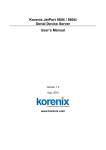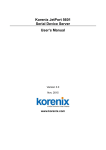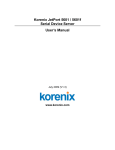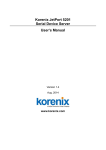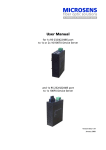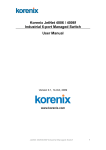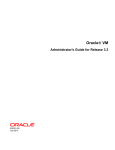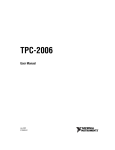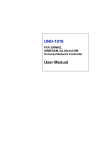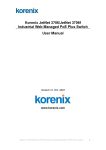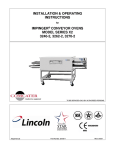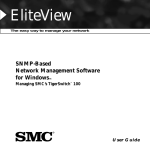Download Manual - Korenix
Transcript
Korenix JetPort 5804 / 5804i Wireless Serial Device Server User’s Manual Version 1.1 Aug. 2014 www.korenix.com Korenix JetPort 5804 / 5804i Wireless Serial Device Server User’s Manual Copyright Notice Copyright 2014 Korenix Technology Co., Ltd. All rights reserved. Reproduction in any form or by any means without permission is prohibited. 2 Contents 1 Introduction .................................................................................................................. 4 1.1 Serial to Ethernet Technology Overview ........................................................................ 5 1.2 Product Features ........................................................................................................... 5 1.3 Product Specification ..................................................................................................... 5 1.4 Package Checklist ......................................................................................................... 8 2 Hardware Installation ................................................................................................... 9 2.1 2.2 Panel and LEDs........................................................................................................... 10 5804 Panel and Interfaces ................................................................................................. 10 5804i Panel and Interfaces ................................................................................................ 10 5804/5804i LED Indicators .................................................................................................. 11 Reset Button ................................................................................................................ 11 2.3 Connecting the Power ................................................................................................. 12 2.4 Connecting the Network .............................................................................................. 12 2.5 Wireless LAN Architecture ........................................................................................... 13 2.6 Wireless Security ......................................................................................................... 14 2.7 Connecting the Serial Device ....................................................................................... 15 2.8 Digital Input/Output ...................................................................................................... 16 2.9 DIN-Rail Mounting Installation ..................................................................................... 18 2.10 Wall-Mounting Installation ............................................................................................ 19 3 Windows Management Tool....................................................................................... 21 3.1 Software Quick Setup .................................................................................................. 22 Install JetPort Commander ............................................................................................. 22 4 Web and Telnet Console ............................................................................................ 26 4.1 4.2 Web Console ............................................................................................................... 27 Server Configuration ....................................................................................................... 27 Port Configuration............................................................................................................ 29 Serial Setting ...................................................................................................................... 29 Service Mode- Real/Virtual COM ....................................................................................... 31 Service Mode- TCP Server ................................................................................................ 32 Service Mode- TCP Client .................................................................................................. 32 Service Mode- UDP............................................................................................................ 33 Management ..................................................................................................................... 34 DI/DO Status ...................................................................................................................... 34 IP Filtering .......................................................................................................................... 35 Event Notification ............................................................................................................... 35 Email and SNMP Trap Notification ..................................................................................... 37 Maintenance ....................................................................................................................... 38 SSH Console ............................................................................................................... 39 SSH Client .......................................................................................................................... 39 Configuration ...................................................................................................................... 41 Appendix A SNMP MIB II and RS-232 Like Support ................................................ 42 Appendix B RS-232 Pin Assignment ........................................................................ 44 Appendix C Revision History .................................................................................... 46 3 1 Introduction JetPort 5804 series is a 4-ports Serial to Wireless Device Server. JetPort 5804 provides 4 3-in-1 RS-232/422/485 serial interfaces. JetPort 5804i provides 4 RS-422/485 serial interfaces with 2KV isolation protection. You can use one IP address, dual redundant paths to control maximum 4 serial devices over the Ethernet. The Wireless LAN solution is 802.11b/g with up to 54Mbps bandwidth. Give you an easy solution to the hard-to-wire or moving environment. Ease your network cabling problem in the field. Protect your serial data transmission with 128 bit WEP over the Wireless LAN and avoid the illegal access or hack. The JetPort 5804 series supports RTTD technology so that the dual Ethernet ports can auto-recovery within 200ms. JetPort 5804 series are also equipped with abundant value-added hardware features include the 2 types of power inputs, 4 Digital Input and 2 Digital Output. JetPort 5804 series can be configured by JetPort Commander, the easy-to-use utility for Windows and the HTTPS and SSH for secured management. The Notification includes the Email alert, System log, SNMP traps and Digital Output for pre-defined events. This chapter describes: Serial to Ethernet Technology Overview Product features Product specification Package checklist JetPort 5804 Wireless Serial Device Server User’s Manual 4 1.1 Serial to Ethernet Technology Overview Korenix JetPort serial device servers provide perfect solution to manage serial devices via Ethernet in flexible ways, such as TCP server, TCP client, UDP, or Windows virtual COM. JetPort creates a transparent gateway for the serial communication to Ethernet. If the control program uses network standard API, you can choose TCP or UDP as the communication protocol. If the control program uses COM port, you can install the Windows driver to add virtual COM ports. 1.2 Product Features JetPort 5804/5804i has the following features: Four-port RS-232/422/485 to 802.11b/g (up to 54Mbps) Wireless network (5804) Four-port RS-422/485 with Isolation to 802.11b/g (up to 54Mbps) Wireless network (5804i) Serial ports supports 2KV isolation protection (5804i) Encrypted data transmission with 128-bit WEP and WPA External antenna expands the range of WLAN Fiberglass antenna for water, dust and UV resistance RTTD, Redundant to the Device function Dual Ethernet Ports, network auto-recovery in 200ms Four Digital Inputs and Two Digital Outputs Redundant Power Inputs by 12-48VDC Terminal Block and DC Jack. Independent serial services, Real/Virtual COM, TCP Server/Client/Tunnel and UDP Connections JetPort Commander, Easy-to-use Windows Utility with smart setup Wizards. Secured Management by HTTPS and SSH Event Notification by Syslog, Email, SNMP trap, and Digital Output Vertical mounting by Din-Rail, Wall mount and Desk-top 1.3 Product Specification Network Interface WLAN Standard Spread Spectrum Technology 802.11b/g WLAN DSSS(802.11b), OFDM(802.11g) Tx Power 13-17dBm at maximum radiation direction Rx Sensitivity -71 dBm @ 54 Mbps, -84 dBm @ 11Mbps Transmission Rate 54 Mbps (max.) with auto fallback JetPort 5804 Wireless Serial Device Server User’s Manual 5 Transmission Distance Up to 100 meters (open area) Antenna Supports the antenna diversity function Ethernet 2* 10/100BaseTX, Redundant Dual Ethernet Connector RJ-45 Feature Auto Recovery in less than 200ms, Auto MDI/MDI-X Protection Built-in 1.5 KV magnetic isolation protection Protocols IP, TCP, UDP, ICMP, DHCP, BootP, ARP/RARP, SNMP, HTTPS, SSH, SNTP, SMTP Serial Communication Number of Ports 4 Interface RS-232, RS-422, RS-485 2/4-wire (5804) RS-422, RS-485 2/4-wire with 2KV Isolation Protection (5804i) Connectors male DB9 Baud Rates 110 bps to 460.8 Kbps Data Bits 5, 6, 7, 8 Parity odd, even, none Stop Bits 1, 1.5, 2 RS-232 TxD, RxD, RTS, CTS, DTR, DSR, GND, DCD RS-422 Tx+,Tx-, Rx+, Rx-,GND RS-485 (4-wire) Tx+,Tx-, Rx+, Rx-,GND RS-485 (2-wire) Data+, Data-,GND Flow Control XON/XOFF, RTS/CTS, DTR/DSR Serial Line Protection 15KV ESD Long Distance 2*pin 120ohm DIP switches Termination Digital Input/Output Number of DI 4 Power Input voltage 5V/TTL Logic 0: 0.8V max (0-0.8V) Logic 1: 2.0V min (2-5V) Number of DO 2 Power Output voltage 5V/TTL Logic 0: 0.8V max (0-0.8V) Logic 1: 2.0V min (2-5V) Features LED Power 1: Startup(Red); Ready(Green); WLAN Link (Orange) Power 2: Startup(Red); Ready(Green) Ethernet port: Left:100M Link (Green On) / Activity(Green Blinking) JetPort 5804 Wireless Serial Device Server User’s Manual 6 Right:10M Link (Orange On) /Activity(Orange Blinking) Serial 1/2/3/4:TX only(Green), RX only(Red), Both RX/TX(Orange) Configuration Windows Utility-JetPort Commander, HTTP, Telnet Serial Service Real COM, Virtual COM, TCP Server, TCP Client, TCP Tunnel and UDP Reset Software reload default, Hardware reset button Beeper Embedded beeper for positioning RTTD Redundant to the Device, Auto-recover in less than 200ms SNTP For time management Access IP Table 16 IP addresses to prevent illegal users Monitor Devices’ status, RCOM/VCOM status SNMP RFC1213 MIB II, RFC1317 RS232_like and SNMP Trap E-Mail Alert Automatic e-mail warning by pre-defined events System Log Trap to Syslog server or local display System Events Cold/Warm Start, Login Failed, IP and Password Changed, Access IP Blocked, DI/DO changed, Serial Port DCD/RI/DSR/CTS changed, Serial Port connected/disconnected. Windows Utility JetPort Commander Device Discovery, Auto IP, Network Setting, Device and Serial Port Setting and monitoring, Notification setting, Firmware Upgrade, Configuration Backup and Restore, Group Configuration Wizards. Serial Service Mode Real COM, Virtual COM, TCP Server, TCP Client, TCP Tunnel and UDP Advanced Serial TCP Alive Check Timeout, Inactivity Idle Timeout, Performance Setting mode, Delimiter, Force TX Timeout for Data Packing and Force TX interval time Group Configuration JetPort Commander: Group IP Wizard, Group firmware upgrade, Wizard Group Backup/Restore, RCOM, VCOM and TCP Tunnel Setup Wizard Power Requirements System Power PWR1: 12~48VDC Terminal Block PWR2: 12~48VDC Power Jack with Power Adapter Power Line protection 1 KV Burst (EFT), EN61000-4-4 0.5 KV Surge, EN61000-4-5 Power Consumption Maximum 4.7 Watts Mechanical Dimensions 145mm(W)x120mm(D)x46.5mm(H) Regulatory Approvals FCC Class A, CE Class A , RoHS Environmental JetPort 5804 Wireless Serial Device Server User’s Manual 7 Operating Temperature -10℃ ~55℃ Operating Humidity 5% ~ 95%, non-condensing Storage Temperature -40℃ ~ 85 ℃ 1.4 Package Checklist JetPort is shipped with the following items: Wireless Device Server Antenna 100-240VAC Power adapter Din-Rail/Wall Mount kit Foot pads Documentation and Software CD Quick Installation Guide If any of the above items is missing or damaged, please contact your local sales representative. JetPort 5804 Wireless Serial Device Server User’s Manual 8 2 Hardware Installation JetPort serial device server can be configured by Windows utility, web browser, or Telnet console. Advanced management features include SNMP support and Email alert. JetPort Commander is a powerful Windows utility that supports device discovery, group setup, group firmware update, and monitoring functions. This chapter introduces how to quick start JetPort Panel and LEDs Reset Button Connecting the Power Connecting the Network Connection the Serial Device Wireless LAN Architecture Wireless Security Digital Input/Output DIN Rail Mounting Installation Wall Mounting Installation JetPort 5804 Wireless Serial Device Server User’s Manual 9 2.1 Panel and LEDs 5804 Panel and Interfaces Din Rail kit WLAN, Antenna Redundant Dual 10/100M Ethernet. Auto-Recovery < 200ms Auto MDI/MDIX Digital I/O 4 Digital Input and 2 Digital HW Reset Output LED for power 1, power 2 and 4 serial RX/TX 12-48VDC PWR 1: Terminal Block 4 RS-232/422/485 ports, DB9 PWR 2: Power Jack 15 KV ESD for all signals 110 bps to 460.8 Kbps Long Distance RS-422/485 120 ohm Termination Wall-Mounting plate and Mounting kit 5804i Panel and Interfaces Din Rail kit WLAN, Antenna Redundant Dual 10/100M Ethernet. Auto-Recovery < 200ms Auto MDI/MDIX Digital I/O 4 Digital Input and 2 Digital HW Reset Output LED for power 1, power 2 and 4 serial RX/TX 12-48VDC 4 RS-232/422/485 ports with PWR 1: Terminal Block 2KV Isolation Protection PWR 2: Power Jack 15 KV ESD for all signals 110 bps to 460.8 Kbps Long Distance RS-422/485 120 ohm Termination Wall-Mounting plate and Mounting kit JetPort 5804 Wireless Serial Device Server User’s Manual 10 5804/5804i LED Indicators There are 6 LEDs in 5804/5804i front panel and 2 LED in RJ-45 ports, indicating real-time system status. LED PWR 1 Color Indication Red On: Power 1 is on and booting up. Blinking: Indicates an IP conflict, or DHCP or BOOTP server did not respond properly. Orange On: Power is on and functioning normally. Blinking: Located by Administrator’s Location function. On: WLAN is linking. Off Power is off, or power error condition exists. Red On: Power 2 is on and booting up. Blinking: Indicates an IP conflict, or DHCP or BOOTP server did not respond properly. Green On: Power 2 is on and functioning normally. Blinking: Located by Administrator’s Location function. Off Power is off, or power error condition exists. Left Green: 100M Ethernet cable is connected. Green Blinking: Traffic is transmitting or receiving. Right Orange: 10M Ethernet cable is connected. Orange Blinking: Traffic is transmitting or receiving. Off Ethernet cable is disconnected, or has a short. Left Green: 100M Ethernet cable is connected. Green Blinking: Traffic is transmitting or receiving. Right Orange: 10M Ethernet cable is connected. Orange Blinking: Traffic is transmitting or receiving. Off Ethernet cable is disconnected, or has a short. Red Serial port is receiving data. Green Serial port is transmitting data. Orange Serial port is receiving and transmitting data. Off No data is being transmitted or received through the serial port. Red Serial port is receiving data. Green Serial port is transmitting data. Orange Serial port is receiving and transmitting data. Off No data is being transmitted or received through the serial port. Red Serial port is receiving data. Green Serial port is transmitting data. Orange Serial port is receiving and transmitting data. Off No data is being transmitted or received through the serial port. Red Serial port is receiving data. Green Serial port is transmitting data. Orange Serial port is receiving and transmitting data. Off No data is being transmitted or received through the serial port. Green PWR 2 Eth 1 Eth 2 S1 S2 S3 S4 2.2 Reset Button The Reset button provides users with a quick and easy way to restore the default settings of JetPort. Press reset button for 10 seconds. Release after Power LED blinking red. JetPort will restore to default value including default IP address (192.168.10.2), and no password. When the Power LED turns green, the device is ready to function. JetPort 5804 Wireless Serial Device Server User’s Manual 11 2.3 Connecting the Power Terminal Block (PWR1): 1. Insert the positive and negative wires of your DC supply into the V+ and V- contacts of the terminal block connector. (GND / V- / V+) 2. Tighten the terminal screws to prevent the DC wires from coming loose. Power Jack(PWR2): Connect the power jack input with the enclosed 12VDC power adapter, or 24VDC power input. The power LED will show red color until the system is ready. If the IP setting is running correctly, the power LED will turn green. Note: If the 2 power inputs are connected (PWR 1, PWR 2), the JetPort 5804 will be powered from the highest connected voltage. The unit will not alarm for loss of DC IN power, the alarm function only applies to loss of power at PWR1 or PWR2. 2.4 Connecting the Network LAN Interface Connect the Ethernet cable to the JetPort 5804/5804i 10/100M Ethernet port 1, 2 or both. The interfaces support auto MDI/MDIX. If both of the Ethernet port 1 and 2 are connected when startup device, the Ethernet port 1 will be the master port, Ethernet port 2 will be the backup. But, if Ethernet port 2 is attached first before attach port 1, the Ethernet port 2 will remain the master port. The major purpose of the LAN interface is for you to configure the SSID for WLAN interface. Run JetPort Commander to manually configure the SSID or Auto Search the available remote Access Point (AP). Refer to the manual of the JetPort Commander to see how to configure SSID. WLAN Interface Screw the attached Wireless Antenna when you get the unit. Always rotate the antenna clockwise to change the direction. JetPort 5804 Wireless Serial Device Server User’s Manual 12 Note: Only one of the LAN or WLAN interface can work. When connecting LAN and WLAN at the same time, the LAN interface has higher priority than WLAN interface. 2.5 Wireless LAN Architecture There are 2 typical WLAN architectures, one is infrastructure, and the other is Ad-Hoc mode. Infrastructure mode: The 2 ends communicate via Access Point (AP). Access Point is the base station which allows WLAN clients connect to. Each AP can accept several clients depend on the network performance you plan to give. Usually up to 10-20 clients. The AP works like a hub, the connected clients share the bandwidth it supports. For example: The AP supports 802.11g which means the available Ad-Hoc mode: The 2 ends communicate with each other directly. In this architecture, there is no need any access point. The JetPort and the host PC or 2 JetPorts can communicate with each other directly. SSID: SSID is short of the Service Set Identifier, it is referred to as a network name that identifies a wireless network. The SSID is attached to the header of packets sent over the WLAN. The 2 ends of the communication pairs should have the same SSID. This also can be viewed as one kind of password for the WLAN end devices. To configure the WLAN settings, no matter Infrastructure or Ad-Hoc mode. You should know the SSID of the 2 ends first. In infrastructure mode, you should know the SSID of the access point and configure this in the JetPort. In Ad-hoc mode, you should configure the same SSID for the JetPort and host PC or 2 JetPorts. Configure the SSID of the Access Point (AP) by JetPort Commander when you first use the WLAN interface or when you move to JetPort 5804 to the range of the other AP. Unplug the LAN port or power reboot the device, then the WLAN interface can connect to the Access Point (AP) you assigned. It may JetPort 5804 Wireless Serial Device Server User’s Manual 13 take few seconds to connect to the WLAN AP when you unplugging the LAN interface. Refer to the WLAN LED can help you to see the WLAN connection status. Channel: In each region, it defines the channels of the wireless band. When choosing Infrastructure mode, the channel of the JetPort is automatically decided by the Access Point. This is to avoid the conflict and easy maintaining the WLAN performance. In Ad-hoc mode, you should assign the same channel to the 2 ends. Transmission Rate: The JetPort 5804 supports 802.11b and 802.11g standard. The typical transmission rate of the 802.11b is 11Mbps, the 802.11g is 54Mbps. The transmission rate of JetPort is “Auto”. It’d use the best transmission rate it can meet in that environment. The transmission rate may also decide by the Access Point. The network installation may also affect this, weak signal or poor connection will reduce the rate. 2.6 Wireless Security JetPort 5804 supports several types of Wireless security protection. No Encryption: Disable the Wireless encryption. WEP: WEP is abbreviation of the Wired Equivalent Privacy. WEP is a security protocol for WLAN. It is designed to provide the same level of security as that of a wired LAN. WEP aims to provide security by encrypting data over radio waves so that the serial data is protected from JetPort 5804 to the Access Point (AP) or another end station. There are 4 types WEP encryption you can choose: Character Input: 5 Characters [WEP64] Character Input: 13 Characters [WEP128] Hexadecimal Input: 10 digits [WEP64] Hexadecimal Input: 26 digits [WEP128] After choosing the encryption type, you can type the Key in the below field. There are 4 keys you can configure and save; one of the key can work at one time. JetPort 5804 Wireless Serial Device Server User’s Manual 14 The 5804 also supports WPA (Wi-Fi Protected Access). WPA was created by the Wi-Fi Alliance; it was designed to enhance the security of wireless networks. WPA has better protection than WEP. JetPort 5804 supports WPA Personal mode. This mode is designed for the networks which don’t require the complex 802.1x authentication server. The WPA personal mode requires manual configuration of a PSK (Previously Share Key) on the AP and Client. The PSK is a passphrase (password), each client must enter a passphrase to access the network, the security depends on the strength of the passphrase. The passphrase may be from 8 to 63 printable ASCII characters or 64 hex decimal digits (256 bits). The passphrase you typed will be stored in JetPort thus you can use this passphrase to communicate with the AP. JetPort 5804 WPA supports 2 encryption modes, TKIP and AES. TKIP is short of Temporal Key Integrity Protocol. It’s an enhancement to WEP security. TKIP uses the RC4 stream cipher with 128-bit keys for encryption and 64-bit keys for authentication. TKIP helps to ensure that only the intended audience understands the transmitted data. AES is short of Advanced Encryption Standard. 5804 provides encryption support AES. Choose the encryption type, TKIP or AES, then type the key in the WPA-PSK and time in the Key Renewal Period (minutes) field. Note: The above security settings should be the same in your access point (AP) and JetPort. Incorrect password/key may lead you lost the connection. 2.7 Connecting the Serial Device JetPort 5804 serial port is a standard DB9 male port. Connect the serial device to the unit DB9 male port by the pin assignment table. The Long-Range Termination switch can configure 120ohm termination for RS-422/4-wire RS-485/2-wire RS-485. JetPort 5804 Wireless Serial Device Server User’s Manual 15 Pin Assignment Pin # RS-232 RS-422 RS-485 (4 wire) RS-485(2 wire) 1 DCD RXD- RXD- 2 RXD RXD+ RXD+ 3 TXD TXD+ TXD+ DATA+ 4 DTR TXD- TXD- DATA- 5 GND GND GND GND 6 DSR 7 RTS 8 CTS 9 RI *RS-232 mode act as DTE 120ohm DIP DIP 1 DIP 2 120ohm Termination Configuration ON ON 120ohm Terminator for Long Distance 4-wire RS-485/RS-422 ON OFF --- OFF ON 120ohm Termination for Long Distance 2-wire RS-485 OFF OFF No Termination for RS-232/485 (short distance) 2.8 Digital Input/Output JetPort 5804 series provides 4 digital inputs and 2 digital outputs. It allows users to connect the termination units’ 5V TTL digital input/output. JetPort Commander allows you to monitor the status of the DI and DO, and set the value 0 or 1 to DO. JetPort also provides one data port for user to program DI/O get and set commands. The logic Low (Value=0) power voltage is 0-0.8V, 0.8V is the max value. The logic High (Value =1) power voltage is 2-5V, 2V is the min value. The Digital I/O pin can be pulled high or low, thus the connected equipments can actively drive these pins high or low. When the digital output of the connected device pulls high to the digital input pin of 5804, or program the digital output value of the connected device to high, the 5804 can trigger the value and display 1 (logic high) in the JetPort Commander. When the connected device pulls low or program to low, JetPort 5804 Wireless Serial Device Server User’s Manual 16 the 5804 can display 0 (logic low). The Digital Output pin should be connected to 5V TTL digital input of the connected device. When user set the value to 1(high), the connected device can receive circuit from 5804 and will be pulled to 1 as well. Or you can connect the digital output pin to the 5V relay output board. Then connect the alarm beeper, lights to the relay output board. You can see the same function as the Relay Output of JetNet switches. Note: The Digital Output feature is not Relay Output board design, it should be connected to digital I/O by pair. Connect digital input of connected device to digital output of 5804 or digital output of the connected device to digital input of 5804. 2.6.1 How to setup DI/O by JetPort Commander DI: You can read the status of the DI. 0 means logic Low. 1 means logic High. When connect DI with DO of other terminal device, the DI can display the DO status of the terminal device. DO: You can read and set the status of the DO. 0 means logic Low, 1 means logic High. Click the 0/1 button, you can change its value to 1 or 0. means logic High for DO_1. means logic Low for DO_1. 2.6.2 How to Program DI/O by the opened data port The JetPort opens a data port for user to program. The programming socket port is 0x901 (2305). You can telnet to the device with TCP port number 2305. Below are the related commands: Programming Commands getdo get DO status getdi get DI status setdo set DO Programming command parameters: getdo/getdi No parameters. setdo DO status string. Ex: “1:0” (status delimiter is “:”, order is “DO_1: DO_2”) Note: command should with “\r\n” at end. JetPort 5804 Wireless Serial Device Server User’s Manual 17 Programming returns: getdo Return DO status string. (2 DO) Ex: “1:0\n\r”. (delimiter is “:”, order is “DO_1:DO_2”, “\n\r” is end flag.) getdi Return DI status string. (4 DI) Ex: “1:0:1:0\n\r”. (delimiter is “:”, order is “DI_1: DI_2:DI_3:DI_4”, “\n\r” is end flag.) setdo Return “OK” when success. Return error message when failure (like: “Unknown command, No DO status given”). And end flag is “\n\r”. 2.9 DIN-Rail Mounting Installation The DIN-Rail clip is already attached to the JetPort 5804 Series products when packaged. If the DIN-Rail clip is not screwed on the JetPort, follow the instructions and the figure below to attach the DIN-Rail clip to the JetPort. 1. Use the screws to attach the DIN-Rail clip to the rear panel of the JetPort 5804/5804i. To remove the DIN-Rail clip, reverse step 1. Follow the steps below to mount the JetPort to the DIN-Rail track. 1. First, insert the upper end of the DIN-Rail clip into the back of the DIN-Rail track from its upper side. (Note: Here we use JetNet Industrial Ethernet Switch as an example.) 2. Lightly push the bottom of the DIN-Rail clip into the track. JetPort 5804 Wireless Serial Device Server User’s Manual 18 3. Check if the DIN-Rail clip is tightly attached on the track. The figure shows the 5804 and 5804i are attached on the track well. 4. To remove the JetPort from the track, reverse the steps above. 2.10 Wall-Mounting Installation Follow these steps to mount the unit to a wall or other flat surface. 1. Use a screwdriver to attach the wall-mounting plate to the back of the JetPort using the six screws provided. Wall-Mounting plate and screws. JetPort 5804 Wireless Serial Device Server User’s Manual 19 2. Use a screwdriver to secure the Wall Mount kit to the wall-mounting plate. Wall-Mounting Kits. 3. Lightly push the Wall-mounting kit into the track like the method described in Din Rail mounting installation. The figure shows the 5804 is attached on the track well. 4. To remove the unit from the wall and from the wall-mounting plate, reverse steps 1-3. JetPort 5804 Wireless Serial Device Server User’s Manual 20 3 Windows Management Tool JetPort serial device server provides powerful Windows management tool for multiple device management. Below are the major functions in JetPort Windows Commander. This chapter introduces you the Software Quick Setup. You can know how to install the JetPort Commander and setup the virtual COM mode. The “JetPort Commander Manual” introduces the full configuration of JetPort commander. You can find the document in product CD or download from Korenix web site. Server Configuration Broadcast Configuration General Locate Security Networking Notification Management Firmware Update Save / Reload Port Configuration Port Serial Settings Port Service Mode Port Notification Setup Wizard Real/Virtual COM Wizard Serial Tunnel Wizard Group IP Wizard Group Setup Wizard Group Firmware Wizard IP Collection Monitor JetPort 5804 Wireless Serial Device Server User’s Manual 21 3.1 Software Quick Setup JetPort Commander is an easy-to-use utility with auto device discovery in a LAN or adding devices on the public network. All of the configurations on the serial server can be done in the JetPort Commander. You can also apply configurations of one serial server to the other serial servers. This document shows you how to quick setup the software. The full functions and configurations’ description, please refer to the JetPort Commander Manual which you can find in the CD or download from Korenix web site. Install JetPort Commander 1. Insert the CD and auto-run the program. Select “JetPort Commander”, and run JetPort Commander.exe to install Windows utility, JetPort Commander. It automatically detects OS of your PC. It will also turn on the Windows7’s test mode. Then you should reboot your PC for the settings to take effect. After you reboot your PC, you should see a test mode watermark on the screen. JetPort 5804 Wireless Serial Device Server User’s Manual 22 2. Broadcast the JetPort unit: Connect the Admin PC to the LAN interface of the JetPort 5804. JetPort Commander will broadcast the network and search all available JetPort units in the network. The default IP address of JetPort is “192.168.10.2”. Product Tip: If you have multiple Network Adapters (i.e. wireless and wired), please activate ONLY ONE Network Adapter that can locate the JetPort devices, and CLOSE the rest Network Adapters. Otherwise, JetPort Commander may broadcast INCORRECTLY. 3. Configuring the JetPort unit: 3.1 Click on the JetPort unit and select “Add” for further configuring the unit. 3.2 Select “Static IP” if you want to specify the network parameters, or select “DHCP” or “BootP” if you want dynamic configuration for the JetPort unit. 4. Configure the JetPort WLAN setting: 4.1 Select the target unit’s IP address. Go to “Wireless” and assign Network Type to “Infra” (Infrastructure mode). 4.2 Press “SSID Scan” and select the available SSID. 4.3 If you can’t find the SSID, manually configure the SSID in the SSID field. 4.4 Press “Apply and Save” to apply this setting. 5. Configure the WLAN IP Address: JetPort 5804 Wireless Serial Device Server User’s Manual 23 5.1 Go to “Networking” -> “Wireless” 5.2 Select “Static IP” if you want to specify the network parameters, or select “DHCP/BootP” if you want dynamic IP configuration for the JetPort unit. 6. Unplug the LAN interface or power reboot the JetPort 5804 to activate the WLAN connection. Run step 3 to find the JetPort 5804 through the WLAN connection. 7. Configuring the serial port as COM port: 7.1 Go to “Configuration”, and choose the “device” and the “port”. Select “Serial Settings” to configure the serial parameters Note: In 5804 series, you can see 4 serial ports, port 1, 2, 3 and 4. Port 1 is Serial 1, Port 2 is Serial 2, Port 3 is Serial 3, and Port 4 is Serial 4. 7.2 Select “Service mode” , “Real/Virtual COM Mode” and press “Map COM” to map the port to the COM port. JetPort 5804 Wireless Serial Device Server User’s Manual 24 Congratulations! You have finished JetPort configurations with Real/Virtual COM mode. You can also use web or telnet console by the JetPort IP address. Note: This document shows you how to quick setup the software. The full functions and configurations’ description, please refer to the JetPort Commander Manual which you can find in the CD or download from Korenix web site. JetPort 5804 Wireless Serial Device Server User’s Manual 25 4 Web and Telnet Console In addition to Windows utility, JetPort 5804 can also be managed by Web-HTTPS and the SSH Console. The HTTPS is a security protocol that provides communication privacy over the internet. The HTTPs packets transmitted between the JetPort and PC would be encrypted. The SSH allows users to securely login to remote host computers, to execute commands safely in a remote computer, to securely copy remote files and to provide secure encrypted and authenticated communications between tow non-trusted hosts. This chapter describes: 4.1 HTTPS Console Server Configuration Port Configuration Management Maintenance 4.2 SSH Console SSH Client Configuration JetPort 5804 Wireless Serial Device Server User’s Manual 26 4.1 Web Console When the JetPort has been configured with proper IP address and the web management is enabled, you can use web browser to make further configurations. Type JetPort’s IP address in the Address input box, for example https://192.168.10.2 (Note: you can just type http://, this is not allowed in HTTPS. Your should type https://.) Trust the JetPort. The popup window will ask you to trust the JetPort product. Press Yes to trust the product and then you can use the web UI of JetPort. If the JetPort is password protected, use the pre-assigned password to login first. The overview page lists the basic information of this JetPort device. Server Configuration Basic Setting configures Server name, Time Server, and Telnet console enable/disable. JetPort 5804 Wireless Serial Device Server User’s Manual 27 Network Setting configures the IP address, Netmask, Gateway, and DNS server for the JetPort. Auto IP Report is for dynamic IP address reporting in defined intervals. Wireless Setting configures the Network Type, SSID and Wireless Encryption for the Wireless LAN settings. “SSID Scan” can scan the available APs in the network. Or manually configure the SSI in the SSID field. Wireless Encryption settings include WEP, TKIP and AES (WPA). Type the same settings as your AP’s setting otherwise you can use the Wireless LAN network. JetPort 5804 Wireless Serial Device Server User’s Manual 28 You can also define Administration password to protect the JetPort from unauthorized modification. Avoid using space in password. Port Configuration Serial Setting Port Configuration covers Serial Parameter settings for each serial port, such as Interface type, Baud Rate, Data Bits, Stop Bits, Parity, Flow Control, Force TX Interval Time and Performance mode. Serial Port: Port 1 / Port 2 / Port 3 / Port 4 Port Alias: Remark the port to hint the connected device. Interface: RS-232 / RS-422 / RS-485(2-wires) / RS-485(4-wires) JetPort 5804 Wireless Serial Device Server User’s Manual 29 Baud rate: from 110bps to 460.8kbps Data Bits: 5, 6, 7, 8 Stop Bits: 1, 2 (1.5) Parity: No, Even, Odd, Mark, Space Flow Control: None, XON/XOFF, RTS/CTS, DTR/DSR Force TX Interval Time is to specify the timeout when no data has been transmitted. When the timeout is reached or TX buffer is full (4K Bytes), the queued data will be sent. Zero means disable (factory default). Performance: Throughput, Latency Throughput mode guarantees highest transmission speed Latency mode guarantees shortest response time For advanced data packing options, you can specify delimiters for Serial to Ethernet and / or Ethernet to Serial communications. You can define max. 4 delimiters (00~FF, HEX) for each way. The data will be hold until the delimiters are received or the optional “Flush Data Buffer After” times out. Zero means disable (factory default). JetPort 5804 Wireless Serial Device Server User’s Manual 30 Flush Data Buffer After is to specify the timeout time if the device doesn’t receive the Delimiters user setup. Service Mode- Real/Virtual COM Select the Serial Port you want to configure first. In Real/Virtual COM mode, you can define the Idle Timeout, Alive Check, and Max. Connections allowed from 1 to 5. Note: Since JetPort’s Real/Virtual COM driver is implemented in JetPort Commander. You should run the JetPort Commander to assign the RCOM/VCOM number. You can only change the related parameters in web UI. Idle Timeout: When serial port stops data transmission for a defined period of time (Idle Timeout), the connection will be closed and the port will be freed and re-try for connection with other hosts. Zero is disable this setting (default). If Multilink is configured, only the first host connection is effective for this setting. Alive Check: The JetPort device will send TCP Alive Check packet in each defined time interval (Alive Check) to remote host to test the TCP connection. If the TCP connection is not alive, the connection will be closed and the port will be freed for other hosts. Zero is to disable this setting Default time is 420. Note: If you want to auto-connect your Real/Virtual COM when power on the device, you should JetPort 5804 Wireless Serial Device Server User’s Manual 31 enable Alive Check. The Alive Check will re-connect virtual COM after booted up. Service Mode- TCP Server In TCP Server mode, you need to select the Serial Port, define the available TCP port number, Idle timeout, Alive check, and Max. connections allowed from 1 to 5. TCP Server Port: This is to assign the available TCP port number. The port number of TCP Server and TCP Client should be the same. Idle Timeout: When serial port stops data transmission for a defined period of time (Idle Timeout), the connection will be closed and the port will be freed and re-try for connection with other hosts. Zero is disable this setting (default). If Multilink is configured, only the first host connection is effective for this setting. Alive Check: The JetPort device will send TCP alive check package in each defined time interval (Alive Check) to remote host to test the TCP connection. If the TCP connection is not alive, the connection will be closed and the port will be freed for other hosts. Zero is disable this setting. Default time is 420. Service Mode- TCP Client In TCP Client mode, you need select the Serial Port, define the destination host IP and port number, Idle timeout, Alive check. To deploy multilink, specify up to 4 more hosts IP and Port number. JetPort 5804 Wireless Serial Device Server User’s Manual 32 TCP Server Port: This is to assign the available TCP port number. The port number of TCP Server and TCP Client should be the same. Idle Timeout: When serial port stops data transmission for a defined period of time (Idle Timeout), the connection will be closed and the port will be freed and re-try for connection with other hosts. Zero is disable this setting (default). If Multilink is configured, only the first host connection is effective for this setting. Alive Check: The JetPort device will send TCP alive check package in each defined time interval (Alive Check) to remote host to test the TCP connection. If the TCP connection is not alive, the connection will be closed and the port will be freed for other hosts. Zero is disable this setting (default). Connect on Startup: The TCP Client will build TCP connection once the connected serial device is startup. Connect on Any Character: The TCP Client will build TCP connection once the connected serial device starts to send data. Service Mode- UDP In UDP mode, you need to select the Serial Port, define the destination host IP and Local listen port number. To create more destination hosts, specify the IP range of destination IP and send port number. JetPort 5804 Wireless Serial Device Server User’s Manual 33 Management DI/DO Status DI (Digital Input) Can Get the status of the DI_1, DI_2, DI_3 and DI_4. DO (Digital Output) Can Get and Set the status of the DO_1 and DO_2. Select the value and click Submit to apply the setting. JetPort 5804 Wireless Serial Device Server User’s Manual 34 IP Filtering The IP Filtering is also known as Access IP Table (JetPort Commander). Access IP table specifies the IP address and subnet that can access to the device. The access is based on IP and Netmask combination. Note: Type the IP address and the Netmask before you click Submit. Otherwise, no user can access the device. If the access is open to all hosts, do NOT enable this function. Netmask: The Netmask of the host is 255.255.255.255. Event Notification Specify the events that should be notified to the administrator. The events can be alarmed by means of email, SNMP trap, or system log. Device Notification: Hardware Reset (Cold Start): Rebooting the JetPort will trigger the event Software Reset (Warm Start): Restarting the computer will trigger the event Login Failed: Using wrong password in console will trigger the event IP Address Changed: Changing network setting will trigger the event Password Changed: Changing the password will trigger the event Access IP Blocked: Report blocked IP addresses Redundant Power Change: Power change will trigger the event Redundant Ethernet Change: Ethernet master port change will trigger the event JetPort 5804 Wireless Serial Device Server User’s Manual 35 DI 1 Changed: DI 1 status changed will trigger the event. DI 2 Changed: DI 2 status changed will trigger the event. DI 3 Changed: DI 3 status changed will trigger the event. DI 4 Changed: DI 4 status changed will trigger the event. DO 1 Changed: DO 1 status changed will trigger the event. DO 2 Changed: DO 2 status changed will trigger the event. Select the events and the types of Email, SNMP Trap or Syslog, click Submit to enable it. Port Notification: DCD changed: When DCD (Data Carrier Detect) signal changes, indicating the modem connection status has changed, the event will be triggered. DSR changed: When DSR (Data Set Ready) signal changes, indicating that the data communication equipment is powered off, the event will be triggered. RI changed: When RI (Ring Indicator) signal changes, indicating the incoming of a call, the event will be triggered. CTS changed: When CTS (Clear To Send) signal changes, indicating that the transmission between computer and DCE can proceed. Port connected: In TCP Server Mode, when the device accepts an incoming TCP connection, this event will be trigger. In TCP Client Mode, when the device has connected to the remote host, this event will be trigger. In Real/Virtual COM Mode, when Real/Virtual COM is ready to use, this event will be trigger. Port disconnected: In TCP Server/Client Mode, when the device lost the TCP link, this event will be trigger. In Real/Virtual COM Mode, When Real/Virtual COM is not available, this event will be trigger. JetPort 5804 Wireless Serial Device Server User’s Manual 36 Select the target port, events and the types of Email, SNMP Trap or Syslog, click Submit to enable it. Email and SNMP Trap Notification Email Server configuration includes the mail server’s IP address or domain. If the authentication is required, specify the username and password. There are 4 email addresses you can specify to receive the notification. SNMP Trap configuration includes up to 4 Trap Servers. You need to at least fill in one Trap Server’s IP or domain. The Community is also required information. Do not use the “;” in this column. Location and Contact is optional information. JetPort 5804 Wireless Serial Device Server User’s Manual 37 Maintenance This page allows you to Load Factory Default, Import and Export configuration file and Upgrade Firmware. Load Factory Default: Load default configuration except Network Settings. Import Configuration: Retrieve saved configuration file to apply in the device. Click Browse to choose the configuration file then click the Import command. Export Configuration: Save the current configuration into a file and save the file in current host. Upgrade Firmware: Upgrade to new firmware. Click Browse to select the firmware then click Upgrade command. JetPort 5804 Wireless Serial Device Server User’s Manual 38 4.2 SSH Console For using SSH, you should open the SSH Client, assign the IP of the JetPort you’d like to access and enter the correct Username/Password, then you can enter the SSH console menu. SSH Client There are many free, shareware, trial or charged SSH clients you can find in the internet. For example, PuTTY is a free and popular Telnet/SSH client, we’ll use this tool to tell you how to login the JetPort by SSH. Note: PuTTY is copyright 1997-2006 Simon Tatham. Download PuTTY: http://www.chiark.greenend.org.uk/~sgtatham/putty/download.html JetPort Settings: Enable the “Telnet Management Enable” to enable the SSH feature of JetPort 5804/5804i. Click “Goto Telnet Management” will ask you to open the SSH client. After modifying configuration, be sure to validate the changes by using “Apply Only” or “Apply and Save”. The copyright of PuTTY Open the PuTTY In the Session sub-tree, enter the Host Name (IP Address of your JetPort) and Port number (default = 22). Choose the “SSH” protocol. Then click “Open” to start the SSH session console. JetPort 5804 Wireless Serial Device Server User’s Manual 39 SSH Console is opened. The default username of the SSH public key is admin, password is admin. You can see the console as below: Login as: admin [email protected]’s password: (admin) ************************************************** *** Korenix JetPort Commander *** ************************************************** Input System Password: ***** (The password you setup in the JetPort commander.) Password confirmed. Starting Main Menu. You can start to configure your JetPort by SSH console. JetPort 5804 Wireless Serial Device Server User’s Manual 40 Type the Password you setup in the JetPort Commander. Configuration Configure the device and port by pressing function number or the hinted initial. Press “q” to exit the function. Always press “a” to apply and save change after making a configuration. JetPort 5804 Wireless Serial Device Server User’s Manual 41 Ap p e n d i x A Appendi x A SNMP MIB II and RS-232 Like Support JetPort 5804 has built-in SNMP agent that supports SNMP trap, RFC 1317 RS-232 MIB and RFC1213 MIB-II. The following tables list SNMP variables implemented in JetPort 5804. RFC1213 MIB-II supported SNMP variables System MIB sysDescr sysObjectID sysUpTime sysContact sysName sysLocation sysORLastChange sysORID sysORDescr sysORUpTime Interface MIB ifNumber ifIndex ifDescr ifType ifMtu ifSpeed ifPhysAddress ifAdminStatus ifOperStatus ifInOctets ifInUcastPkts ifInDiscards ifInErrors ifOutOctets ifOutUcastPkts ifOutDiscards ifOutErrors ifOutQLen ifSpecific atPhysAddress atNetAddress Address MIB atIfIndex IP MIB ipForwarding ipDefaultTTL ipInReceives ipInHdrErrors ipInAddrErrors ipForwDatagrams ipInUnknownProtos ipInDiscards ipInDelivers ipOutRequests ipOutDiscards ipOutNoRoutes ipReasmTimeout. ipReasmReqds ipReasmOKs ipReasmFails ipFragOKs ipFragFails ipFragCreates ipAdEntAddr ipAdEntIfIndex ipAdEntNetMask ipAdEntBcastAddr ipRouteDest ipRouteIfIndex ipRouteMetric1 ipRouteNextHop ipRouteType ipRouteProto ipRouteMask ipRouteInfo ipNetToMediaIfIndex ipNetToMediaPhysAddress ipNetToMediaNetAddress ipNetToMediaType ipRoutingDiscards JetPort 5804 Wireless Serial Device Server User’s Manual 42 ICMP MIB icmpInMsgs icmpInErrors icmpInDestUnreachs icmpInTimeExcds icmpInParmProbs icmpInSrcQuenchs icmpInRedirects icmpInEchos icmpInEchoReps icmpInTimestamps icmpInTimestampReps icmpInAddrMasks icmpInAddrMaskReps icmpOutMsgs icmpOutErrors icmpOutDestUnreachs icmpOutTimeExcds icmpOutParmProbs icmpOutSrcQuenchs icmpOutRedirects icmpOutEchos icmpOutEchoReps icmpOutTimestamps icmpOutTimestampReps icmpOutAddrMasks icmpOutAddrMaskReps TCP MIB tcpRtoAlgorithm tcpRtoMin tcpRtoMax tcpMaxConn tcpActiveOpens tcpPassiveOpens tcpAttemptFails tcpEstabResets tcpCurrEstab tcpInSegs tcpOutSegs tcpRetransSegs tcpConnState tcpConnLocalAddress tcpConnLocalPort tcpConnRemAddress tcpConnRemPort tcpInErrs tcpOutRsts UDP MIB udpInDatagrams udpNoPorts udpInErrors udpOutDatagrams udpLocalAddress udpLocalPort SNMP MIB snmpInPkts snmpOutPkts snmpInBadVersions snmpInBadCommunityNames snmpInBadCommunityUses snmpInASNParseErrs snmpInTooBigs snmpInNoSuchNames snmpInBadValues snmpInReadOnlys snmpInGenErrs snmpInTotalReqVars snmpInTotalSetVars snmpInGetRequests snmpInGetNexts snmpInSetRequests snmpInGetResponses snmpInTraps snmpOutTooBigs snmpOutNoSuchNames snmpOutBadValues snmpOutGenErrs snmpOutGetRequests snmpOutGetNexts snmpOutSetRequests snmpOutGetResponses snmpOutTraps snmpEnableAuthenTraps snmpSilentDrops snmpProxyDrops RFC1317 R-S232 supported SNMP variables RS-232 MIB rs232Number rs232PortIndex rs232PortType rs232PortInSigNumber rs232PortInSpeed rs232PortOutSpeed rs232PortInFlowType rs232PortOutFlowType rs232AsyncPortIndex rs232AsyncPortBits rs232AsyncPortStopBits rs232AsyncPortParity rs232AsyncPortParityErrs rs232AsyncPortFramingErrs rs232AsyncPortOverrunErrs rs232InSigPortIndex rs232InSigName rs232InSigState rs232InSigChanges rs232OutSigPortIndex rs232OutSigName rs232OutSigState rs232OutSigChanges JetPort 5804 Wireless Serial Device Server User’s Manual rs232PortOutSigNumber rs232AsyncPortAutobaud 43 Appendix B Appendi x B RS-232 Pin Assignment Name Notes/Description DCD Data Carrier Detect RXD Receive Data (RxD, Rx) TXD Transmit Data (TxD, Tx) DTR Data Terminal Ready GND Ground DSR Data Set Ready RTS Request To Send CTS Clear To Send RI Ring Indicator JetPort 5804 Wireless Serial Device Server User’s Manual 44 Appendix C: About Korenix Less Time At Work! Fewer Budgets on applications! The Korenix business idea is to let you spend less time at work and fewer budgets on your applications. Do you really want to go through all that trouble but still end up with low quality products and lousy services? No! This is why you need Korenix. Korenix offers a complete products selection that fulfills all your needs for your applications. We bring you easier, faster, tailor-made services, and more reliable solutions. In Korenix, there is no need to compromise. Korenix takes care everything for you! Fusion of Outstandings Your searching stops here. Korenix Technology is your one-stop supply center for industrial communications and networking products. Established by a group of professionals with more than 10 years of experience in the arenas of industrial control, data communications and industrial networking applications. Korenix Technology is well-positioned to fulfill your needs and demands by providing a great variety of tailor-made products and services. Korenix’s industrial-grade products also come with quality services. No more searching, and no more worries. Korenix Technology stands by you all the way through. Core Strength---Competitive Price and Quality With our work experience and in-depth know-how of industrial communications and networking, Korenix Technology is able to combine Asia’s research / development ability with competitive production cost and with quality service and support. Global Sales Strategy Korenix’s global sales strategy focuses on establishing and developing trustworthy relationships with value added distributors and channel partners, and assisting OEM distributors to promote their own brands. Korenix supplies products to match local market requirements of design, quality, sales, marketing and customer services, allowing Korenix and distributors to create and enjoy profits together. Quality Services KoreCARE--- KoreCARE is Korenix Technology’s global service center, where our professional staffs are ready to solve your problems at any time and in real-time. All of Korenix’s products have passed ISO-9000/EMI/CE/FCC/UL certifications, fully satisfying your demands for product quality under critical industrial environments. Korenix global service center’s e-mail is [email protected] 5 Years Warranty Each of Korenix’s product line is designed, produced, and tested with high industrial standard. Korenix warrants that the Product(s) shall be free from defects in materials and workmanship for a period of five (5) years from the date of delivery provided that the Product was properly installed and used. This warranty is voided if defects, malfunctions or failures of the warranted Product are caused by damage resulting from force majeure (such as floods, fire, etc.), environmental and atmospheric disturbances, other external forces such as power line disturbances, host computer malfunction, plugging the board in under power, or incorrect cabling; or the warranted Product is misused, abused, or operated, altered and repaired in an unauthorized or improper way Korenix Technologies Co., Ltd. 5F, No. 98-1, Ming-Chuan Rd., Shing Tien City, Taipei, TaiwanTel:+886-2-89111000 Fax:+886-2-29123338 Business service : [email protected] Customer service: [email protected] JetPort 5804 Wireless Serial Device Server User’s Manual 45 C Appendi x C Revision History Version Description Date V1.1 Update Korenix phone & fax number. Aug. 2014 V1.0 The first released version. Mar. 2013 JetPort 5804 Wireless Serial Device Server User’s Manual 46














































